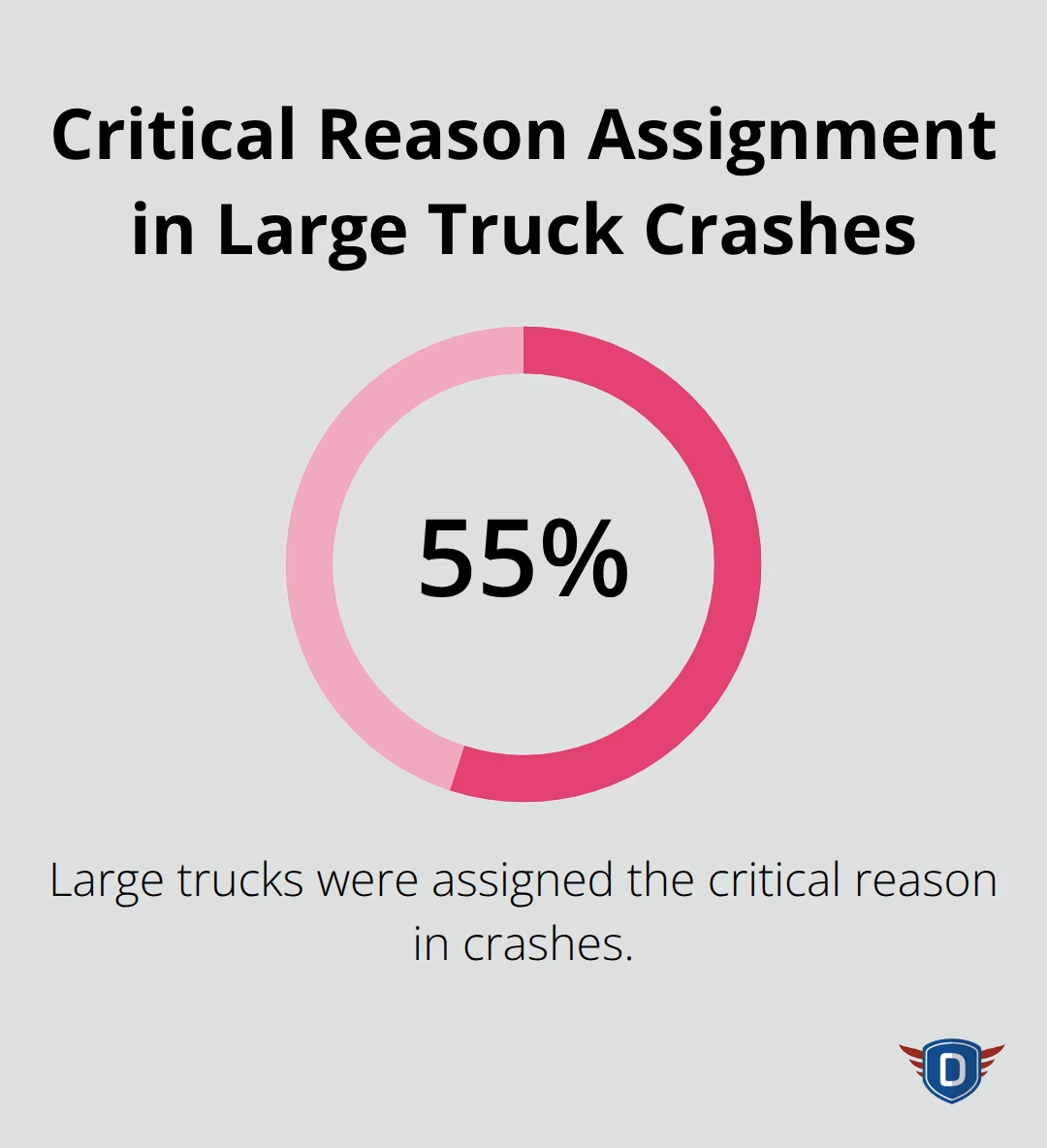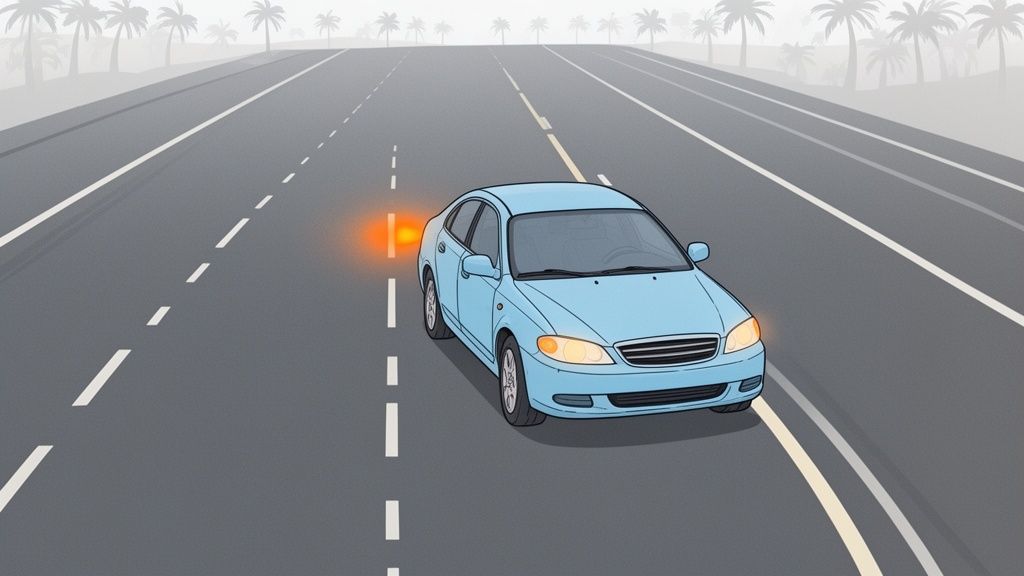Long-haul trucking demands skill, focus, and a commitment to safety. At DriverEducators.com, we understand the unique challenges faced by truckers on extended journeys.
This guide offers essential safe driving tips for truckers, covering everything from pre-trip preparation to managing fatigue and implementing defensive driving techniques.
By following these strategies, you’ll be better equipped to handle the rigors of long-distance hauling and contribute to safer roads for everyone.
How to Prepare for a Long-Haul Trip
Comprehensive Vehicle Inspection
A thorough inspection of your truck is essential before you start your journey. This detailed examination should cover all critical components. Check your brakes, tires, lights, and fluid levels. Brake issues were coded for over a quarter of the trucks but only 2 percent of the passenger vehicles in truck crashes. Don’t become part of that statistic.

Your tires require special attention. Proper inflation and tread depth are vital for safety and fuel efficiency. The American Trucking Associations recommends a tire pressure check before every trip. Underinflated tires can lead to blowouts and reduced fuel economy.
Strategic Route Planning
Plan your route meticulously. Use up-to-date GPS systems and trucking-specific navigation apps to avoid low bridges, weight restrictions, and construction zones. Your advance planning can help you avoid many hazards.
Check weather forecasts for your entire route. Severe weather can dramatically impact travel times and safety. If you face extreme conditions, it’s better to delay your trip than risk an accident.
Essential Packing for Extended Trips
Pack smart for your long haul. Include a well-stocked emergency kit with items like a flashlight, first-aid supplies, and basic tools. The American Red Cross recommends you keep at least a three-day supply of non-perishable food and water in your vehicle for emergencies.
Don’t forget personal items that contribute to your comfort and alertness. Pack healthy snacks to avoid relying solely on truck stop food. Truck drivers have higher rates of heart disease, diabetes, hypertension, and obesity compared to U.S. adult workers, partly due to poor diet on the road.
Bring enough clothing for your trip, including layers for changing weather conditions. A comfortable driver is a more alert driver. The National Sleep Foundation emphasizes the importance of comfort for quality rest, which is critical for long-haul drivers.
Ensure all your documentation is in order. This includes your commercial driver’s license, registration, insurance, and any necessary permits. The FMCSA can impose hefty fines for missing or outdated documentation.
Technology Check
Before departure, make sure all your communication devices are fully charged and functioning. This includes your smartphone, tablet, and any other devices you use for navigation or communication. The National Safety Council stresses the importance of reliable communication tools in case of emergencies.
With these preparations complete, you’re ready to hit the road. But staying alert and managing fatigue during your long haul is equally important. Let’s explore some effective strategies to keep you safe and focused behind the wheel.
How Can Truckers Stay Alert on Long Hauls?
Long-haul trucking requires constant vigilance. 55 percent of large trucks were assigned the critical reason in crashes according to the Large Truck Crash Causation Study. We emphasize the critical nature of staying alert during extended drives. Let’s explore practical strategies to combat drowsiness and maintain peak performance behind the wheel.

Spot Fatigue Before It’s Too Late
Recognize the early signs of fatigue. Watch out for frequent yawning, heavy eyelids, and difficulty focusing on the road. If you find yourself drifting between lanes or missing exits, take immediate action. The National Highway Traffic Safety Administration warns that 18 hours of wakefulness equals a blood alcohol concentration of 0.08% (significantly increasing crash risk).
Strategic Rest: Your Lifeline on the Road
Create a rest schedule that aligns with your body’s natural rhythms. The Federal Motor Carrier Safety Administration advises against driving between midnight and 6 AM, when your body naturally craves sleep. Plan your breaks strategically. Try to take a 15-30 minute nap every 4 hours of driving. This can dramatically improve alertness and reaction times.
Fuel Your Body for the Long Haul
Your diet plays a pivotal role in maintaining alertness. Choose protein-rich snacks and complex carbohydrates that provide sustained energy. Avoid heavy meals that can induce drowsiness. Stay hydrated, but be mindful of excessive caffeine intake (which can lead to a crash later). The American Trucking Associations recommends keeping a cooler stocked with healthy options to avoid relying solely on truck stop fare.
Move Your Body, Boost Your Energy
Incorporate regular exercise into your routine. Even brief stretches during breaks can boost energy levels and improve overall health. The Centers for Disease Control and Prevention suggests at least 150 minutes of moderate-intensity aerobic activity per week. Break this down into short, manageable sessions throughout your trips.
Leverage Technology for Alertness
Use technology to your advantage. Many trucking companies now offer fatigue monitoring systems that can detect signs of drowsiness and alert drivers. Some apps can also help you track your sleep patterns and suggest optimal rest times. While these tools can be helpful, they should complement, not replace, your own judgment and awareness.
Staying alert isn’t just about following rules-it’s about preserving your life and the lives of others on the road. As we move forward, let’s examine how defensive driving techniques can further enhance your safety on long hauls.
How Can Truckers Master Defensive Driving?
The Space Cushion Technique
Maintaining a safe following distance is a key defensive driving strategy. Large trucks need additional space between vehicles to allow for safe braking and unexpected actions. This extra space provides more time to react to sudden changes in traffic or road conditions.
In adverse conditions, increase this distance. If you drive in rain, fog, or on icy roads, double your following distance.
Weather-Wise Driving
Challenging weather conditions demand extra caution. When visibility decreases due to fog, heavy rain, or snow, reduce your speed immediately. Approximately 12 percent of crashes – nearly 745,000 – are weather-related.

In extreme conditions, don’t hesitate to pull over. It’s better to arrive late than not at all. If you must continue, use your low beams in fog and turn on your hazard lights if you travel significantly below the speed limit.
Smooth Transitions: Lane Changes and Merges
Proper lane changing and merging procedures are essential for truck safety. Always signal your intentions well in advance – at least 100 feet before changing lanes in urban areas and 300 feet on highways.
Before changing lanes, check your mirrors and blind spots carefully. The “lean and look” method can help you spot vehicles in your blind spots. Lean forward in your seat to change your line of sight and look over your shoulder.
When merging, be aware that other drivers might not understand the limitations of your vehicle. Accelerate smoothly to match the speed of traffic in the lane you’re entering. If another vehicle refuses to yield, it’s often safer to slow down and merge behind them rather than force your way in.
Constant Vigilance
Defensive driving requires more than just reacting to immediate dangers. It involves constantly scanning the road ahead, anticipating potential problems, and making decisions that keep you and others safe. Try to look at least 15 seconds ahead of your vehicle (about a quarter-mile on highways) to identify potential hazards early.
Proper Communication
Use your turn signals, brake lights, and horn effectively to communicate your intentions to other drivers. In situations where you need to slow down suddenly, activate your hazard lights to warn drivers behind you. Clear communication can prevent many accidents (especially those involving rear-end collisions, which account for a significant percentage of truck-related crashes).
Final Thoughts
Safe trucking requires continuous learning and improvement. We covered essential safe driving tips for truckers, from thorough pre-trip preparations to staying alert on long hauls and mastering defensive driving techniques. These strategies form the foundation of a successful and secure career in long-haul trucking.
The trucking industry evolves constantly, and staying informed is key to your safety and success. We encourage you to seek additional training opportunities and stay updated on industry developments. Your commitment to safety impacts not only your life but also the lives of others on the road.
At DriverEducators.com, we help drivers develop the skills and knowledge needed for safe, confident driving. Our comprehensive driver education programs and experienced instructors provide valuable insights for both new and experienced truckers (looking to enhance their skills).





